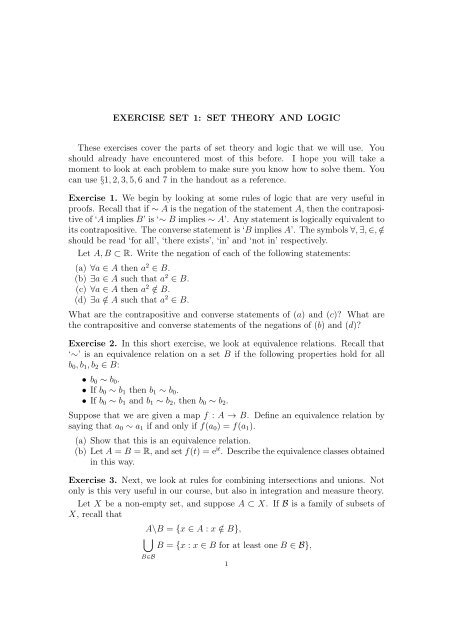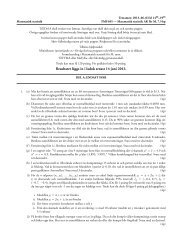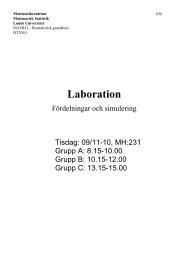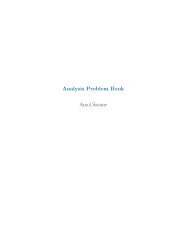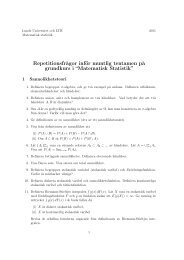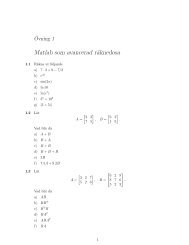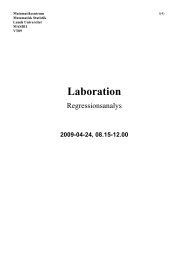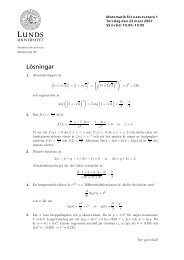EXERCISE SET 1: SET THEORY AND LOGIC These exercises ...
EXERCISE SET 1: SET THEORY AND LOGIC These exercises ...
EXERCISE SET 1: SET THEORY AND LOGIC These exercises ...
- No tags were found...
Create successful ePaper yourself
Turn your PDF publications into a flip-book with our unique Google optimized e-Paper software.
2 <strong>EXERCISE</strong> <strong>SET</strong> 1: <strong>SET</strong> <strong>THEORY</strong> <strong>AND</strong> <strong>LOGIC</strong>⋂B = {x : x ∈ B for every B ∈ B}.B∈BShow that the following holds.(a) A ∪ ( ⋂ B∈B B) = ⋂ B∈B(A ∪ B).(b) A\( ⋃ B∈B B) = ⋂ B∈B (A\B).(c) A\( ⋂ B∈B B) = ⋃ B∈B (A\B).(Hint: First show that the right-hand side is contained in the left-hand side.)Exercise 4. Here are some additional formulas on intersections and unions, thistime in combination with the cartesian product. Recall thatA × B = {(a, b) : a ∈ A, b ∈ B}.Let A 1 , A 2 ⊂ A and B 1 , B 2 ⊂ B. Then(a) (A 1 × B 1 ) ∩ (A 2 × B 2 ) = (A 1 ∩ A 2 ) × (B 1 ∩ B 2 ).(b) (A 1 × B 1 )\(A 2 × B 2 ) = [(A 1 \A 2 ) × (B 1 \B 2 )]∪ [(A 1 ∩ A 2 ) × (B 1 \B 2 )]∪ [(A 1 \A 2 ) × (B 1 ∩ B 2 )].Exercise 5. Let f : A → B be a map. Suppose that A 0 ⊂ A and B 0 ⊂ B. Recallthat by definitionf −1 (B 0 ) = {x ∈ A : f(x) ∈ B 0 }.Moreover, f is injective if f(x) = f(y) implies x = y, and f is surjective if for ally ∈ B there exists x ∈ A such that f(x) = y. Prove the following:(a) A 0 ⊂ f −1 (f(A 0 )), and equality holds ∀A 0 ⊂ A if and only if f is injective.(b) f(f −1 (B 0 )) ⊂ B 0 , and equality holds ∀B 0 ⊂ B if and only if f is surjective.Suppose in addition that A 1 ⊂ A and B 1 ⊂ B.(c) A 0 ⊂ A 1 implies f(A 0 ) ⊂ f(A 1 ).(d) B 0 ⊂ B 1 implies f −1 (B 0 ) ⊂ f −1 (B 1 ).Also show that:(e) f(A 0 \A 1 ) ⊃ f(A 0 )\f(A 1 ), and equality holds ∀A 0 , A 1 ⊂ A if and only if fis injective.(f) f −1 (B 0 \B 1 ) = f −1 (B 0 )\f −1 (B 1 ).Suppose in addition that B is a family of subsets of B.(g) f −1 ( ⋃ B∈B B) = ⋃ B∈B f −1 (B).(h) f −1 ( ⋂ B∈B B) = ⋂ B∈B f −1 (B).Finally, suppose that A is a family of subsets of A.(i) f( ⋃ A∈A A) = ⋃ A∈A f(A).(j) f( ⋂ A∈A A) ⊂ ⋂ A∈Af(A), and equality holds ∀A if and only if f is injective.
<strong>EXERCISE</strong> <strong>SET</strong> 1: <strong>SET</strong> <strong>THEORY</strong> <strong>AND</strong> <strong>LOGIC</strong> 3Exercise 6. Recall that a set X is said to be countable if there exists an bijectivemap (injective and surjective) f : N → X. Heuristically, we check that there areat least as many elements in X is in N (the map is injective), and that there areno more elements in X than in N (the map is surjective). An equivalent wayto formulate this definition is to say that to each element of X we can associatea unique number n ∈ N, and this is done for each n ∈ N. I.e., we can writeX = {x n } n∈N .Show that:(a) the set of all integers Z is countable.(b) Z × Z is countable.(c) the set of all rational numbers Q is countable.Let A be a countable family of countable subsets of A. I.e., there exists anenumeration such that A = {A n } n∈N , and each A n is countable. Show that:(d) ∪ A∈A A is countable.(e) A 1 × · · · × A n is countable.Exercise 7. We turn to uncountability. Recall that a set X is uncountable if thereexists an injective map f : N → X, but no such map is surjective. Heuristically,we can say that we check that there are at least as many elements in X as in N(the map is injective), and moreover that there actually exists ’more’ elements inX than in N (we cannot find a surjective map).(a) Set X = {0, 1}. Show that X × X × · · · × X × · · · is uncountable. (Here wetake the cartesian product a countable number of times.)(b) Show that R is uncountable.(c) Give an example where A is an uncountable family of countable sets, and∪ A∈A A is uncountable.


